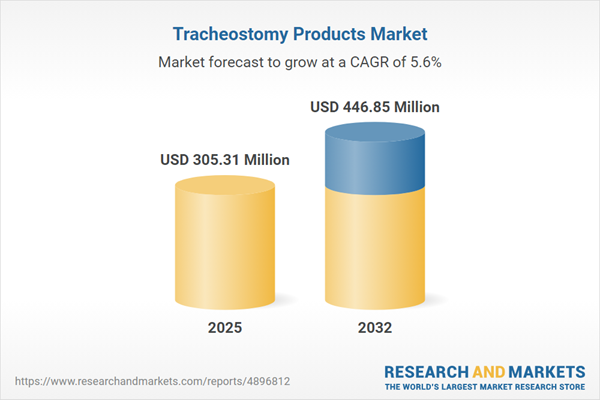Speak directly to the analyst to clarify any post sales queries you may have.
Senior decision-makers in the tracheostomy products market are navigating a landscape influenced by regulatory changes, evolving care delivery, and shifting procurement strategies. Staying agile and informed is essential for maintaining strong operational performance and meeting the growing complexities of respiratory intervention needs.
Market Snapshot: Tracheostomy Products Market Overview
In 2024, the tracheostomy products market is valued at USD 289.26 million, with projections indicating growth to USD 305.31 million by 2025 and reaching USD 446.85 million by 2032, at a compound annual growth rate (CAGR) of 5.58%. Rising global rates of chronic respiratory conditions, particularly in older demographics, continue to fuel demand for advanced respiratory devices. Technological enhancements are expanding both the function and application of tracheostomy products, supporting acute and long-term patient management. Additionally, digital integration within procurement and care coordination fosters broader market access, facilitating seamless device availability in established healthcare systems as well as emerging markets.
Scope & Segmentation: Insights on the Tracheostomy Products Market
- Product Types: The market encompasses cuffed tubes, foam cuff alternatives, high-volume low-pressure devices, and fenestrated tubes, each designed to provide flexibility in ventilation. Metal tubes are chosen for high-demand clinical settings, and single or double lumen cannulas address varied patient requirements.
- End Users: Primary users include hospitals, ambulatory surgery centers, respiratory clinics, and home care providers. Each segment prioritizes device specifications and clinician training differently, reflecting the diversity of services, patient acuity, and required clinical workflows.
- Distribution Channels: Access is achieved through direct procurement, specialized distributors, strategic alliances, and emerging online platforms, all aimed at streamlining delivery and enhancing product support.
- Material Types: Medical-grade metals, quality PVC, and silicone are selected to meet global safety standards, helping to limit patient risk during tracheostomy procedures.
- Age Groups: Devices are available for adults, pediatrics, and neonates, ensuring all patient populations benefit from tailored tracheostomy solutions.
- Applications: Designed for both urgent airway management and ongoing ventilatory support, these devices adapt to different patient care environments—helping clinical teams manage varying acuity levels safely and efficiently.
- Regional Coverage: The scope includes the Americas, Europe, Asia-Pacific, and the Middle East & Africa. Unique care protocols, procurement expectations, and regulatory oversight across these regions require customized strategies in compliance, distribution, and product deployment.
- Company Developments: Industry trends such as collaborative innovation, strategic shifts, and continuous design improvements are shaping competitive dynamics and overall market direction.
Key Takeaways: Strategic Insights for Senior Decision-Makers
- Flexible procurement structures ensure consistent product availability, supporting stable supply across both centralized and home-based care models.
- Material innovations, including antimicrobial surfaces and reinforced device integrity, strengthen infection control measures and promote patient safety over extended use periods.
- Integrating digital monitoring with telemedicine optimizes patient care transitions and enhances interdisciplinary management across the continuum of care.
- Emphasis on device portability combined with targeted clinician education encourages reliable adoption in home-respiratory care environments, improving patient experiences beyond traditional healthcare settings.
- Ongoing professional training and timely device upgrades aid compliance with evolving clinical regulations and support reimbursement optimization within complex healthcare payment frameworks.
- Digital procurement solutions and automated inventory management enable swift response to fluctuating demand and align purchases with broader operational strategies, minimizing supply disruptions.
Tariff Impact on the Tracheostomy Products Market
The introduction of US tariffs on specific medical device components has impacted sourcing strategies, introducing variable pricing and affecting device availability. Manufacturers are adapting by diversifying suppliers and pursuing regional partnerships, which helps mitigate dependency risks and maintain consistent access to tracheostomy products amid regulatory and geopolitical shifts.
Methodology & Data Sources
The research process involved direct interviews with leading clinicians and procurement executives. Findings were further supported through targeted industry surveys, peer-reviewed literature, validated data repositories, and current regulatory frameworks, ensuring accuracy and actionable results.
Why This Tracheostomy Products Market Report Matters
- Provides executive leaders with guidance to align procurement and operational strategies with shifting compliance requirements and market trends.
- Offers practical approaches to address clinical, technological, and logistical challenges, ensuring sustainable care delivery and business continuity.
- Empowers organizations to prepare for transition points in healthcare delivery and capitalize on emerging market opportunities based on robust, evidence-driven analysis.
Conclusion
This report equips senior decision-makers with essential insights to navigate regulatory, procurement, and operational challenges, positioning organizations to succeed in the evolving tracheostomy products market.
Additional Product Information:
- Purchase of this report includes 1 year online access with quarterly updates.
- This report can be updated on request. Please contact our Customer Experience team using the Ask a Question widget on our website.
Table of Contents
3. Executive Summary
4. Market Overview
7. Cumulative Impact of Artificial Intelligence 2025
Companies Mentioned
The companies profiled in this Tracheostomy Products market report include:- Medtronic plc
- Smiths Group plc
- Teleflex Incorporated
- Becton Dickinson and Company
- Avanos Medical, Inc.
- Ambu A/S
- Merit Medical Systems, Inc.
- Intersurgical Ltd.
- Westmed, Inc.
- Tracoe medical GmbH
Table Information
| Report Attribute | Details |
|---|---|
| No. of Pages | 189 |
| Published | October 2025 |
| Forecast Period | 2025 - 2032 |
| Estimated Market Value ( USD | $ 305.31 Million |
| Forecasted Market Value ( USD | $ 446.85 Million |
| Compound Annual Growth Rate | 5.5% |
| Regions Covered | Global |
| No. of Companies Mentioned | 11 |









